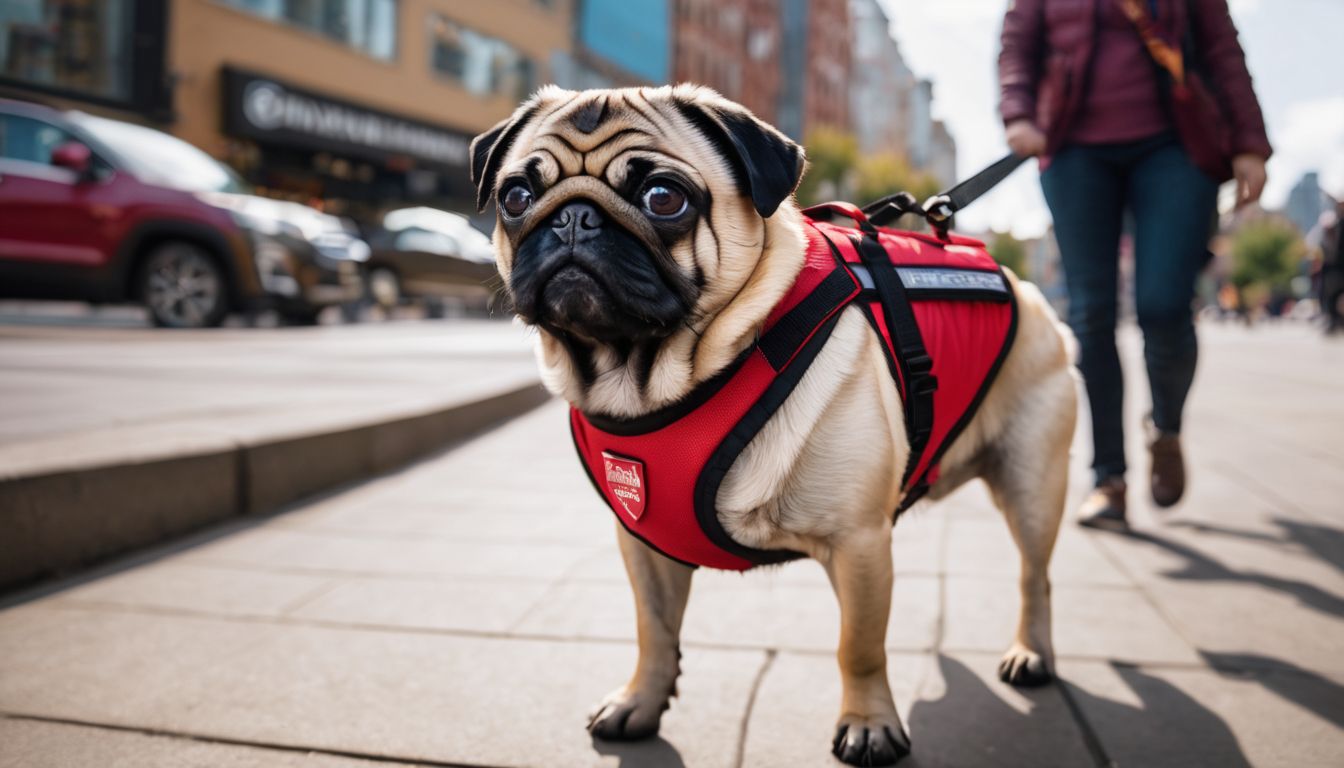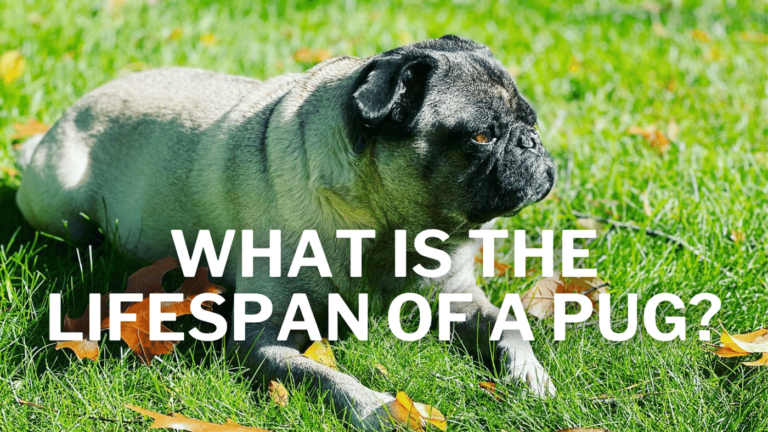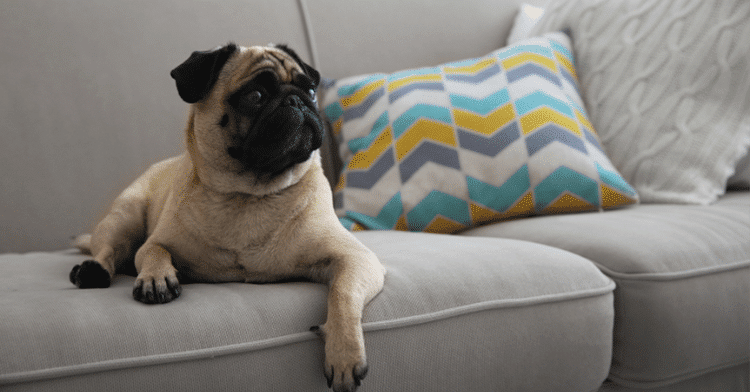Can Pugs Really Be Trained As Service Dogs?
Can Pugs be Service Dogs?
Have you ever caught yourself marveling at your cute little pug and wondering, “Could this bundle of joy also be my knight in shining armor?” Well, it turns out you’re not the only one tickled by that thought.
We’ve shared a few chuckles and sips of coffee over the same question before rolling up our sleeves to dig for some heartwarming truths. What we’ve unearthed is nothing short of delightful – these charming nuggets have an untapped potential to take on roles typically snagged by their bigger cousins.
Imagine having more than just a snuggle buddy; what if your pint-sized pal could become an everyday superhero? Keep scrolling as we peel back the layers and reveal how these underdogs might just surprise us all with their tenacity.
Who’s ready to rethink what small can do?
Key Takeaways
- Pugs can be trained as service dogs for specific tasks, especially those related to providing emotional support and assisting with less physically demanding needs.
- Proper training is essential for pugs to become reliable service animals. This includes mastering obedience and task-specific skills through patient, consistent practice using positive reinforcement methods.
- Despite their size, pugs’ intelligence and eagerness to please make them good candidates for service work; they can adapt well to different environments and routines.
- Having a pug as a service dog comes with benefits such as low maintenance needs, ease of travel due to their compact size, and a gentle temperament ideal for therapy work.
- While not all breeds are traditionally associated with service roles, the individual dog’s training and suitability for the owner’s specific requirements are what determine their potential as a service animal.
What are Service Dogs?
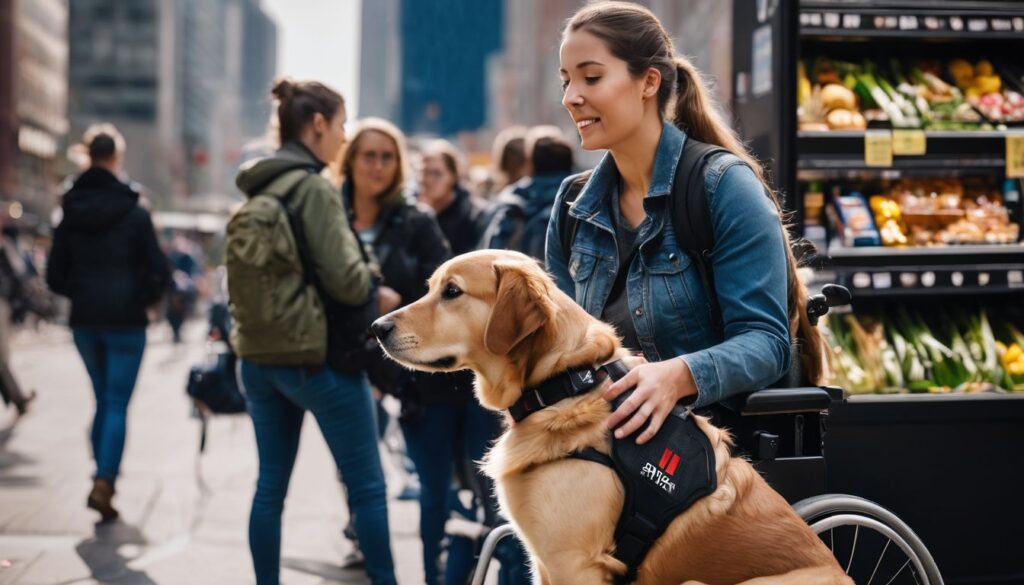
Service dogs are highly trained animals that perform specific tasks for individuals with disabilities, offering them greater independence and support in their daily lives. Beyond companionship, these noble canines play a crucial role in improving the quality of life for those they assist by catering to various physical, sensory, and mental health needs.
Definition of a service dog
A service dog is a trained canine that performs tasks for people with disabilities. These dogs are not just pets; they’re hardworking helpers who make daily life easier for their owners.
From guiding someone who’s blind to alerting a person with diabetes to a drop in blood sugar, these animals are essential companions. They undergo rigorous training to learn specific actions that assist with disability-related functions.
Service dogs come from various breeds, and yes, even our lovable pugs can qualify! We train them to do things like remind individuals to take medication or provide stability and support during mobility challenges.
It’s all about matching the right pup with the right job – and when it comes to giving aid where it’s needed most, pugs have shown they’re up for the task. Their compact size also makes them ideal for those living in smaller spaces or frequently traveling.
Types of service dogs (guide, hearing, mobility, etc.)
Service dogs are amazing companions that assist people with various disabilities. They undergo specialized training to perform specific tasks that their handlers cannot do for themselves.
- Guide Dogs: These dogs are the eyes of individuals who have visual impairments. They help navigate obstacles and lead their handler safely from one place to another.
- Hearing Dogs: People with a significant degree of hearing loss benefit from these service animals. These dogs alert them to important sounds, like alarms, doorbells, or crying babies.
- Mobility Assistance Dogs: Those with mobility issues receive valuable help from these canines. Tasks include picking up dropped items, opening doors, and even pulling wheelchairs.
- Psychiatric Service Dogs: They support individuals coping with mental disabilities such as major depression or PTSD. Unlike emotional support animals, they perform tasks directly related to the disability.
- Diabetes Alert Dogs: Trained to detect low or high blood sugar levels in their handler by scent, these dogs provide an invaluable service in managing diabetes.
- Seizure Response Dogs: They stay close to those with seizure disorders, providing safety measures during a seizure and fetching medication or help as needed.
Characteristics of Service Dogs
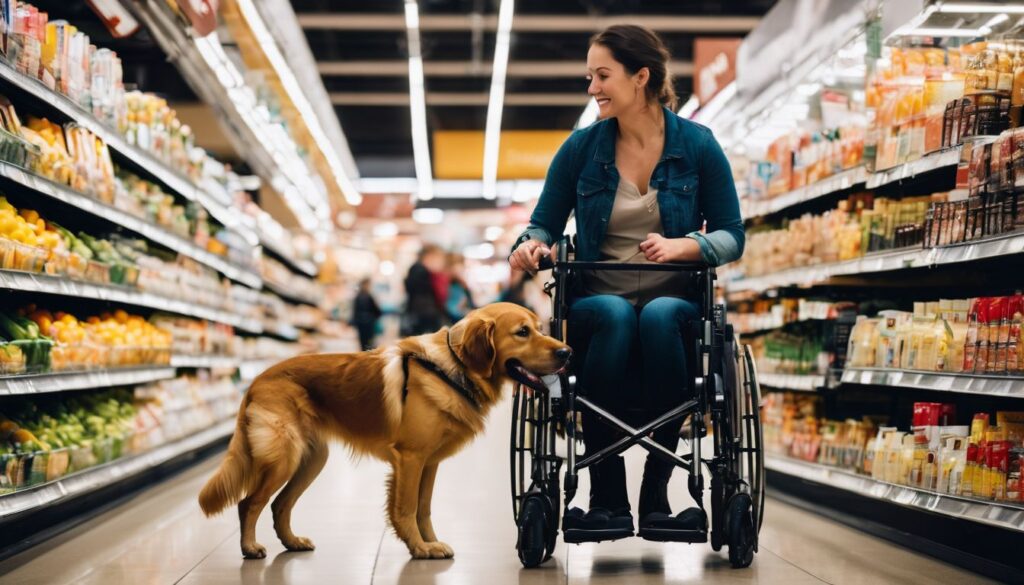
Service dogs are distinguished by their rigorous training and steadfast dependability, traits that are essential for assisting people with various needs. These exceptional animals are more than just pets; they’re highly skilled assistants equipped to handle specific tasks that support individuals with disabilities in their daily lives.
Extensive training
Training a pug to become a service dog is no small feat, but we’re up for the challenge. It begins with basic obedience and moves into more specialized skills tailored to specific needs.
Our pugs learn how to respond to commands accurately and perform tasks that assist their handlers in daily life. This rigorous process ensures they can reliably provide support without getting distracted or overwhelmed.
Trainers dedicate countless hours molding these affectionate little dogs into dependable companions capable of aiding with various disabilities, including mobility impairments and anxiety disorders.
The transformation from playful pups into disciplined service animals is truly remarkable, proving that even the most unexpected breeds can rise to the occasion. Moving forward, let’s explore whether pugs can actually fulfill the role of a traditional service dog.
Reliable nature
After mastering their extensive training, pugs showcase a reliable nature that is essential for service work. We pride ourselves on the dependability of these little companions; they consistently follow through with tasks once trained.
Their ability to adapt and retain what they’ve learned makes them surprisingly good service dogs. These qualities are especially important for individuals who rely heavily on the unwavering support of their canine helpers.
Pugs bring not only reliability but also a sense of security to those in need of assistance. They carry out their duties with careful attention, whether it involves alerting a person with hearing difficulties or providing stability for someone with mobility issues.
Thanks to their easy-going temperament confirmed by many pug owners around the world, these dogs can maintain composure in various environments – from crowded public spaces to quiet homes – making them reliable partners in day-to-day life.
Can Pugs Be Service Dogs?
When we think of service dogs, breeds like Labradors or German Shepherds might come to mind, but what about Pugs? These small and spirited dogs have the potential to take on the role of a service dog, provided they receive the appropriate training tailored to their unique capabilities and size.
Let’s explore how these affectionate canines could possibly serve beyond just companionship.
Pugs are not traditionally thought of as service dogs
Pugs have a reputation for being lovable lapdogs, not the service dogs we’re used to seeing like German Shepherds or retrievers. However, this doesn’t mean they lack the potential to assist those in need.
Their gentle and friendly nature makes them excellent companions, especially for providing emotional support. Despite their small size and whimsical expressions, pugs are intelligent and can be trained to perform specific tasks required by individuals with various needs.
They might surprise you with their capability as service animals. With dedication and proper training, pugs can aid people just as well as other breeds classified under support dogs.
These adaptable canines are capable of learning how to navigate tasks that benefit owners with disabilities—both physical and mental. They may not fit the conventional image of a “working dog,” but they certainly rise to the occasion when given the chance and appropriate guidance.
They can be trained for specific tasks
We’ve seen firsthand that pugs are more than just adorable faces; they have potential as service dogs. Just like larger breeds, these small companions can learn to perform tasks tailored to an owner’s specific needs.
Whether it’s fetching medication, providing stability for someone with mobility issues, or alerting a hearing-impaired person to sounds, our little friends have the capacity to make big impacts.
Training a pug requires patience and consistency due to their stubborn streaks but once focused, they can master commands and cues essential for aiding their human partners. We ensure our furry pals become well-versed in skills important for both emotional support and physical assistance roles.
Their innate sensitivity makes them particularly excellent at picking up on cues that something isn’t right with their owner’s health or emotions—providing comfort when it matters most.
Tips for Adopting a Service Dog
Embarking on the journey of adopting a service dog is not only exciting but also life-changing. It’s crucial to approach this process with diligence and an understanding of what it entails, ensuring you’re fully prepared for the responsibilities and rewards that come with having a pug as your dedicated helper.
Do your research
Before adopting a pug as a service dog, it’s crucial to dive into thorough research. Begin by understanding the specific tasks you’ll need your service dog to perform – this is essential because not every pug might be up to the task due to their size and physical abilities.
Explore training programs that have experience with small breeds like pugs and are familiar with turning their natural traits into strengths for assistance work. Check out registries and organizations for guidelines on what constitutes a qualified service dog, remembering that merely providing emotional support does not meet these criteria.
We must also examine local laws and certifications related to service dogs. Investigate which public spaces and accommodations recognize your pug as a working animal once trained. Learn from others who have gone through this process by connecting with communities of pug lovers who share insights about raising these adorable dogs as reliable helpers.
They can inform you about trainers who excel in nurturing qualities like patience and gentleness—traits making pugs excellent companions for those requiring therapeutic support or aid with daily routines.
Consider the training process
Training a pug to be a service dog involves commitment and careful planning. Since they’re not traditional service dogs, we need to tailor their training to meet specific needs. They must learn to perform tasks that help with a disability, different from simply providing emotional support or being therapy dogs.
Skills like opening doors, fetching items, or alerting someone if their handler is in distress are essential for them to qualify as a service dog.
We have to ensure our pugs undergo thorough training through programs that could last several months. It’s crucial they pass assessments like the Canine Good Citizen test, which measures temperament and behavior.
Equipping them with these skills means dedicating time every day for practice and reinforcement of positive behaviors. Only through persistence can our beloved pugs truly become helpers capable of performing the valuable services required by individuals with disabilities.
Get a dog carrier
As we navigate through the training journey with our pugs, let’s not overlook their comfort during travel. A sturdy dog carrier is essential for ensuring your service dog’s safety and security when on the go.
Choose one that fits your pug snugly but still allows enough room to stand, turn around, and lie down comfortably. This becomes their personal space, a haven where they can retreat to feel secure in new or crowded environments.
Investing in a high-quality carrier also makes vet visits less stressful for both you and your pug. It simplifies transporting them without compromising on comfort—especially crucial since keeping up with vaccinations is an integral part of maintaining their health as a reliable companion animal.
Plus, having a familiar carrier on hand can make all the difference in managing those unexpected moments that require quick mobility with your furry friend by your side.
Keep your pug vaccinated
After ensuring you have a comfortable carrier for your pug, it’s vital to focus on their health. Vaccinations play a crucial role in keeping your service companion safe and ready to assist at all times.
Regular vaccinations protect them from various diseases that can hinder their ability to perform tasks or provide emotional support. It’s not just about following the law; it’s about safeguarding your sidekick’s wellbeing so they can continue offering unfaltering service.
We must keep our pugs up-to-date with their shots as part of their routine care regimen. This includes core vaccines for rabies, distemper, parvovirus, and adenovirus, along with any additional ones recommended by the vet based on where you live and your pug’s unique lifestyle.
Ensuring these furry pals are immunized creates a shield against illness that allows both you and your four-legged friend to navigate public spaces without unnecessary risk—keeping everyone involved healthy and happy while they do their important work.
Understand the commitment
Keeping your pug healthy and vaccinated is just the beginning. Training a pug to become a service dog requires dedication and patience above all else. It’s an ongoing process, not just a one-time event.
We have to be ready to invest time each day into training exercises, socialization, and care routines that ensure our pugs can perform their tasks reliably in various environments.
Embracing this journey means understanding that there are no shortcuts to creating a successful partnership with a service animal. This includes recognizing the importance of consistency in commands and rewards as well as being prepared for the occasional setback.
Our commitment doesn’t end once our pugs learn their initial tasks; we must continually reinforce these behaviors and adapt them as circumstances change or new needs arise. So let’s step up together with open hearts, knowing that raising a service dog is as much about nurturing their skills as it is about fostering an unbreakable bond of trust between us and our beloved companions.
Benefits of Having a Pug as a Service Dog
Discovering the unique advantages of choosing a pug for service work can be an enlightening journey. These affectionate companions bring a special blend of qualities that may perfectly align with your specific needs for assistance and support.
Gentle and friendly nature
We know that a service dog needs to be more than just skilled; they must also show patience and a loving temperament. Pugs excel in this area with their gentle nature, often seeking out cuddles and happily sitting by your side.
Their friendly demeanor means they’re less likely to react negatively to strangers or unexpected situations. These qualities make them particularly useful for providing comfort as therapy dogs, where the calming presence of a non-reactive dog is invaluable.
Our little pug companions bring joy not just with their comical expressions but with their eagerness to please. They adapt well to different environments and can form strong bonds with individuals of any age, making them ideal candidates for those considering an emotional support animal.
With proper training tailored to specific needs, pugs can perform various tasks and offer unwavering companionship as service dogs.
Easy to train
Pugs have a reputation for being eager to please, making them surprisingly easy to train as service dogs. They are intelligent and can learn a variety of tasks that assist people with different needs.
Training a pug requires patience, consistency, and positive reinforcement. Treats work wonders in encouraging them through their training sessions.
Our experience shows that these adaptable little dogs quickly pick up on routines and commands. With their desire to be close to their owners, they naturally pay attention and focus during training.
Their capacity to perform specific duties makes pugs not just lovable pets but also capable companions for those requiring assistance in their daily lives.
Low maintenance
Having a service dog that picks up new commands with ease is one thing, but the day-to-day upkeep is another key consideration. Pugs are known for their low maintenance needs compared to other breeds, which can be quite beneficial for individuals looking for a service dog without the hassle of intensive grooming or excessive exercise requirements.
Their short coat sheds year-round but only requires just a quick brush now and then to keep it neat.
We also appreciate that pugs don’t demand vast amounts of physical activity. A few short walks each day and some playtime will keep them happy and healthy. For those of us who may have mobility issues or lead busy lives, having a service dog like a pug that adapts well to various living environments and doesn’t require hours of outdoor exercise is ideal.
They fit perfectly into any home, big or small, making them excellent companions in almost any setting without lots of extra work on our part.
Easy to travel with
Not only are pugs low maintenance, but their compact size also makes them perfect travel companions. Whether we’re heading out for a quick trip to the store or embarking on a long journey, our little friends can come along without any hassle.
We simply tuck them into a comfortable dog carrier and they’re ready to go. Their adaptable nature means they settle down quickly in new environments, which is ideal for those of us who are always on the move.
With our trusty pug by our side, we never have to worry about leaving an important member of our family behind. They fit easily under airplane seats or on our laps during car rides, ensuring that wherever we go, they can provide the assistance and emotional support we need.
Traveling with a service dog like a pug isn’t just convenient—it’s also comforting to know that help is always within reach no matter where life takes us.
Misconceptions About Service Dogs
Despite common beliefs, not all dog breeds are suitable for service work, and a wagging tail or love for petting doesn’t equate to the rigorous standards set for service dogs—stay tuned to unravel more myths about these canine helpers.
All breeds can be service dogs
Many people think only certain dog breeds can be service dogs, but that’s not true. We see all kinds of dogs working hard to help their humans with disabilities. Pugs may not be the typical seeing eye dog or hearing companion, but they have a lot to offer.
Pugs are known for being eager to please and can learn different tasks just like any other breed.
It’s crucial we understand that it’s not about the breed when it comes to service dogs; it’s about the training and the individual dog’s capabilities. While some breeds are more commonly associated with specific services due to physical attributes or temperament, a pug might be perfect for someone who needs emotional support or less physically demanding tasks.
With patience and proper training, our beloved pugs can become certified service animals ready to assist with a variety of needs.
Emotional support does not make a dog a service dog
We need to clear up a common confusion between emotional support dogs and service dogs. Emotional support can be invaluable, but it doesn’t grant a pooch the legal status of a service dog.
A pug offering comfort with cuddles and kisses is soothing and wonderful for our mental well-being, but under the law, this alone isn’t enough. Service dogs must have specialized training to perform tasks that assist individuals with disabilities.
It’s their ability to take specific actions when needed—like alerting someone with hearing impairments or fetching medication—that sets them apart.
Our beloved pugs have the potential to become therapy dogs due to their affectionate nature; however, becoming a certified service animal involves more than just good behavior or companionship.
Thorough training that focuses on practical assistance directly relates to an owner’s needs is crucial for any breed aspiring to be recognized as a true service dog. While Pugs are indeed capable of learning these skills, simply providing emotional support does not fulfill the criteria established by regulations governing service animals.
Can Pugs be Service Dogs Conclusion
In conclusion, pugs hold real potential as service dogs when provided with appropriate training. Their adaptable and friendly nature makes them well-suited to assist with various tasks.
Embrace the journey of transforming a loving pug into a dedicated helper that can bring joy and support every day. Remember, each dog has unique abilities; your pug may just surprise you with its capabilities as an invaluable companion and aid.
With patience and dedication, owning a service pug is not only possible but also rewarding.
Can Pugs be Service Dogs FAQs
1. Are pugs capable of becoming service dogs for people with disabilities?
Absolutely, pugs can be trained as service dogs to help individuals with mental disabilities. They have a friendly nature that makes them great companions.
2. Can pugs perform tasks like larger service dogs such as pit bulls?
Yes, while they are smaller than pit bulls, pugs can learn various helpful tasks and provide emotional support just like other therapy dogs.
3. Is it okay to pet a pug when it’s working as a service dog?
No, you should not pet any service dog, including a pug when it’s on duty because this could distract the dog from assisting its owner.
4. Will I know if a pug is trained for therapy or is simply a pet?
A therapist often works with therapy dogs and trains them for specific tasks; if you see one with official gear on or in action offering comfort, it’s likely not just someone’s pet but rather trained for therapeutic work.

